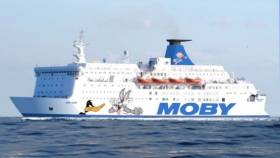Displaying items by tag: Moby Zasa in Med service
Former Cork-Swansea Ferry Debuts On 'Nice' New Service
#NiceNewService - Former Fastnet Line’s Cork-Swansea ferry which was due to enter Mediterranean service later this month, has since our previous report begun sailings on a new France-Corsica service, writes Jehan Ashmore.
The 1,850 passenger/325 car/30 truck Julia which had served two seasons on the Ireland-Wales route closed following insufficient funds to resume sailings in 2012 and after a failed examinership. A previous operator on the Celtic Sea link was Swansea-Cork Ferries which closed after failing to find suitable replacement tonnage for Superferry that was required back by Greek charterers.
Moby Zazà, the renamed ferry for her new French role between Nice and Bastia, Corsica, had in recent years served as a Dutch owned floating accommodation vessel. As the Wind Perfection she was stationed at anchor during a wind-farm installation project in the Irish Sea.
She was then re-sold to Moby Lines the Italian operator that has deployed the 153m long ferry on the new service. Moby also operate an extensive network to and from the Italian mainland to Sardinia, Elba and Sicily. Consequently, the new service is the operators only service connecting just French ports.
The high-season debut of Moby Zazà (1982/22,161gt) sees her operate sailings in tandem with Moby Corse (1978/14,399gt). The former North Sea veteran last month launched the new service for Moby Lines.
Overnight sailings are 9.5 hours while daytime passages are 7.5 hours. The service links the resorts of the French Riviera on the Cote d’Azur with those located on one of the largest islands in the western Mediterranean.
Moby Lines entry on the Nice route marketplace following the collapse of French operator, SNCM which went bankrupt, however after rebranding exercise emerged Corsica Linea this year. SNCM used to serve out of Nice and the successor leaves only existing established operator, Corsica-Sardinia Ferries to compete with Moby Lines.
Among their Corsica-Italy-Elba routes are more veterans from the Irish Sea, Moby Vincent, the one-time St. Brendan which in 1987 operated in a joint operation between B+I Line and Sealink on the Rosslare-Fishguard route.The 1974 built Scandinavian ferry having made her Irish debut as the chartered Stena Normandica.
The Moby Love in its last career served the Isle of Man Steam Packet to the UK mainland as King Orry but not routes to Ireland. As the St. Eloi she served a stint while on relief duties for Sealink British Ferries on the Dun Laoghaire-Holyhead route.






























































